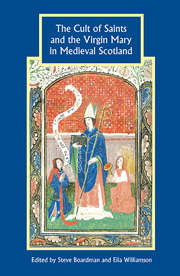Book contents
- Frontmatter
- Contents
- List of Illustrations and Tables
- List of Contributors
- Abbreviations
- Introduction
- 1 The Big Man, the Footsteps, and the Fissile Saint: paradigms and problems in studies of insular saints' cults
- 2 St Munnu in Ireland and Scotland: an exploration of his cult
- 3 The struggle for sanctity: St Waltheof of Melrose, Cistercian in-house cults and canonisation procedure at the turn of the thirteenth century
- 4 Royal and aristocratic attitudes to saints and the Virgin Mary in twelfth- and thirteenth-century Scotland
- 5 A saintly sinner? The ‘martyrdom’ of David, duke of Rothesay
- 6 Wo/men only? Marian devotion in medieval Perth
- 7 Is eagal liom lá na hagra: devotion to the Virgin in the later medieval Gàidhealtachd
- 8 Scottish saints' legends in the Aberdeen Breviary
- 9 Mothers and their sons: Mary and Jesus in Scotland, 1450–1560
- 10 The ‘McRoberts thesis’ and patterns of sanctity in late medieval Scotland
- Index
5 - A saintly sinner? The ‘martyrdom’ of David, duke of Rothesay
Published online by Cambridge University Press: 05 October 2013
- Frontmatter
- Contents
- List of Illustrations and Tables
- List of Contributors
- Abbreviations
- Introduction
- 1 The Big Man, the Footsteps, and the Fissile Saint: paradigms and problems in studies of insular saints' cults
- 2 St Munnu in Ireland and Scotland: an exploration of his cult
- 3 The struggle for sanctity: St Waltheof of Melrose, Cistercian in-house cults and canonisation procedure at the turn of the thirteenth century
- 4 Royal and aristocratic attitudes to saints and the Virgin Mary in twelfth- and thirteenth-century Scotland
- 5 A saintly sinner? The ‘martyrdom’ of David, duke of Rothesay
- 6 Wo/men only? Marian devotion in medieval Perth
- 7 Is eagal liom lá na hagra: devotion to the Virgin in the later medieval Gàidhealtachd
- 8 Scottish saints' legends in the Aberdeen Breviary
- 9 Mothers and their sons: Mary and Jesus in Scotland, 1450–1560
- 10 The ‘McRoberts thesis’ and patterns of sanctity in late medieval Scotland
- Index
Summary
On 25 or 26 March 1402 David, duke of Rothesay, the eldest son and heir of the Scottish king Robert III, died in Falkland castle in Fife while in the custody of his uncle Robert, duke of Albany. David's imprisonment and death were part of an intermittent but long-running struggle for control of the kingdom between the senior line of the royal dynasty represented by Robert III and his sons David and James (the future James I), and the cadet branch of the royal house headed by the duke of Albany. The rivalry between the royal house and the Albany Stewarts in the early fifteenth century goes some way to explain the dramatically divergent accounts of Rothesay's life, arrest and death that appeared after 1402. Men keen to inconvenience and embarrass the duke of Albany depicted Rothesay as a ‘martyr’, a young prince brutally and unjustly killed, starved to death on his uncle's orders in the dungeons of Falkland. Rothesay's supposedly cruel and lingering demise evidently provoked interest beyond the narrow circle of those actively involved in the arena of high politics, for the duke's tomb at Lindores Abbey seems to have become the centre of a miracle-working cult and a (perhaps short-lived) focus for popular pilgrimage in the early decades of the fifteenth century. However, the celebration of Rothesay as a saintly figure was hardly straightforward or universal, for a powerful counter-narrative existed, preserved in a series of fifteenth- and sixteenth-century texts, that characterised Duke David as an immoral, womanising degenerate who had had to be removed from power by his uncle in order to save the kingdom from the baleful effects of his rule.
- Type
- Chapter
- Information
- The Cult of Saints and the Virgin Mary in Medieval Scotland , pp. 87 - 104Publisher: Boydell & BrewerPrint publication year: 2010



